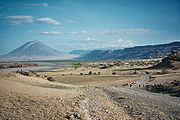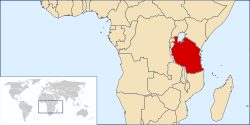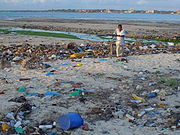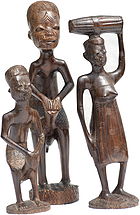
Tanzania
Background to the schools Wikipedia
Arranging a Wikipedia selection for schools in the developing world without internet was an initiative by SOS Children. Child sponsorship helps children one by one http://www.sponsor-a-child.org.uk/.
| United Republic of Tanzania Jamhuri ya Muungano wa Tanzania
|
||||||
|---|---|---|---|---|---|---|
|
||||||
| Motto: "Uhuru na Umoja" ( Swahili) "Freedom and Unity" |
||||||
| Anthem: Mungu ibariki Afrika "God Bless Africa" |
||||||
|
|
||||||
| Capital | Dodoma | |||||
| Largest city | Dar es Salaam | |||||
| Official languages | Swahili (de facto) English (Higher courts, higher education) |
|||||
| Demonym | Tanzanian | |||||
| Government | Republic | |||||
| - | President | Jakaya Kikwete | ||||
| - | Prime Minister | Mizengo Pinda | ||||
| Independence from the United Kingdom | ||||||
| - | Tanganyika | 9 December 1961 | ||||
| - | Zanzibar | 10 December 1963 | ||||
| - | Merger | 26 April 1964 | ||||
| Area | ||||||
| - | Total | 945,203 km2 ( 31st) 364,898 sq mi |
||||
| - | Water (%) | 6.2 | ||||
| Population | ||||||
| - | 2009 estimate | 43,739,000 ( 30th) | ||||
| - | 2002 census | 34,443,603 | ||||
| - | Density | 46.3/km2 ( 124th) 119.9/sq mi |
||||
| GDP ( PPP) | 2009 estimate | |||||
| - | Total | $57.400 billion | ||||
| - | Per capita | $1,416 | ||||
| GDP (nominal) | 2009 estimate | |||||
| - | Total | $22.318 billion | ||||
| - | Per capita | $550 | ||||
| Gini (2000–01) | 34.6 medium |
|||||
| HDI (2008) | Error: Invalid HDI value · 151st |
|||||
| Currency | Tanzanian shilling ( TZS) |
|||||
| Time zone | EAT ( UTC+3) | |||||
| - | Summer ( DST) | not observed ( UTC+3) | ||||
| Drives on the | left | |||||
| Calling code | +2552 | |||||
| ISO 3166 code | TZ | |||||
| Internet TLD | .tz | |||||
| 1 Estimates for this country explicitly take into account the effects of excess mortality due to AIDS; this can result in lower life expectancy, higher infant mortality and death rates, lower population and growth rates, and changes in the distribution of population by age and sex than would otherwise be expected. ² 007 from Kenya and Uganda. |
||||||
Coordinates: 6.307°S 34.854°E The United Republic of Tanzania (pron.: / ˌ t æ n z ə ˈ n iː ə / Swahili: Jamhuri ya Muungano wa Tanzania) is a country in central East Africa bordered by Kenya and Uganda to the north, Rwanda, Burundi and the Democratic Republic of the Congo to the west, and Zambia, Malawi and Mozambique to the south. The country's eastern borders lie on the Indian Ocean.
The United Republic of Tanzania is a unitary republic composed of 26 mikoa (regions). The head of state is President Jakaya Mrisho Kikwete, elected in 2005. Since 1996, the official capital of Tanzania has been Dodoma, where parliament and some government offices are located. Between independence and 1996, the major coastal city of Dar es Salaam served as the country's political capital. Today, Dar es Salaam remains the principal commercial city of Tanzania and the de-facto seat of most government institutions. It is the major seaport for the country and its landlocked neighbours.
The name Tanzania derives from the names of the two states Tanganyika and Zanzibar that united in 1964 to form the United Republic of Tanganyika and Zanzibar, which later the same year was renamed the United Republic of Tanzania.
History
Tanzania is probably one of the oldest known inhabited areas on Earth; fossil remains of humans and pre-human hominids have been found dating back over two million years. More recently, Tanzania is believed to have been populated by hunter-gatherer communities, probably Cushitic and Khoisan speaking people. About 2000 years ago, Bantu-speaking people began to arrive from western Africa in a series of migrations. Later, Nilotic pastoralists arrived, and continued to immigrate into the area through to the 18th century.
Travellers and merchants from the Persian Gulf and Western India have visited the East African coast since early in the first millennium AD. Islam was practised on the Swahili coast as early as the eighth or ninth century AD.
Claiming the coastal strip, Omani Sultan Seyyid Said moved his capital to Zanzibar City in 1840. During this time, Zanzibar became the centre for the Arab slave trade. Between 65% to 90% of the population of Arab- Swahili Zanzibar was enslaved. One of the most famous slave traders on the East African coast was Tippu Tip, who was himself the grandson of an enslaved African. The Nyamwezi slave traders operated under the leadership of Msiri and Mirambo.

In the late 19th century, Imperial Germany conquered the regions that are now Tanzania (minus Zanzibar), Rwanda, and Burundi, and incorporated them into German East Africa. During World War I, an invasion attempt by the British was thwarted by German General Paul von Lettow-Vorbeck, who then mounted a drawn out guerrilla campaign against the British. The post-World War I accords and the League of Nations charter designated the area a British Mandate, except for a small area in the northwest, which was ceded to Belgium and later became Rwanda and Burundi.
British rule came to an end in 1961 after a relatively peaceful (compared with neighbouring Kenya, for instance) transition to independence. In 1954, Julius Nyerere transformed an organization into the politically oriented Tanganyika African National Union (TANU). TANU's main objective was to achieve national sovereignty for Tanganyika. A campaign to register new members was launched, and within a year TANU had become the leading political organisation in the country.
Nyerere became Minister of British-administered Tanganyika in 1960 and continued as Prime Minister when Tanganyika became officially independent in 1961. Soon after independence, Nyerere's first presidency took a turn to the Left after the Arusha Declaration, which codified a commitment to socialism in Pan-African fashion. After the Declaration, banks were nationalised as were many large industries.
After the Zanzibar Revolution overthrew the Arab dynasty in neighboring Zanzibar, which had become independent in 1963, the island merged with mainland Tanganyika to form the nation of Tanzania on 26 April 1964. The union of the two, hitherto separate, regions was controversial among many Zanzibaris (even those sympathetic to the revolution) but was accepted by both the Nyerere government and the Revolutionary Government of Zanzibar owing to shared political values and goals.
From the late 1970s, Tanzania's economy took a turn for the worse. Tanzania also aligned with China, seeking Chinese aid. The Chinese were quick to comply, but with the condition that all projects be completed by imported Chinese labor.
From the mid 1980s, the regime financed itself by borrowing from the International Monetary Fund and underwent some reforms. From the mid 1980s Tanzania's GDP per capita has grown and poverty has been reduced.
Politics
The President of Tanzania and National Assembly members are elected concurrently by direct popular vote for five-year terms. The president appoints a prime minister who serves as the government's leader in the National Assembly. The president selects his Cabinet from among National Assembly members. The Constitution also empowers him to nominate ten non-elected members of Parliament, who also are eligible to become cabinet members. Elections for president and all National Assembly seats were held in December 2005. Tanzania is a one party dominant state with the Chama Cha Mapinduzi in power. Opposition parties are widely considered to have no real chance of gaining power, though the country remains peaceful.
The unicameral National Assembly elected in 2000 has 295 members. These 295 members include the Attorney General, five members elected from the Zanzibar House of Representatives to participate in the Parliament, the special women's seats which are made up of 20 percent of the seats that a given party has in the House, 181 constituent seats of members of Parliament from the mainland, and 50 seats from Zanzibar. Also in the list are forty-eight appointed for women and the seats for the 10 nominated members of Parliament. At present, the ruling Chama Cha Mapinduzi holds about 93 percent of the seats in the Assembly. Laws passed by the National Assembly are valid for Zanzibar only in specifically designated union matters.
Zanzibar's House of Representatives has jurisdiction over all non-union matters. There are seventy-six members in the House of Representatives in Zanzibar, including fifty elected by the people, ten appointed by the president of Zanzibar, five ex officio members, and an attorney general appointed by the president. In May 2002, the government increased the number of special seats allocated to women from ten to fifteen, which will increase the number of House of Representatives members to eighty-one. Ostensibly, Zanzibar's House of Representatives can make laws for Zanzibar without the approval of the union government as long as it does not involve union-designated matters. The terms of office for Zanzibar's president and House of Representatives also are five years. The semiautonomous relationship between Zanzibar and the union is a unique system of government.
Tanzania has a five-level judiciary combining the jurisdictions of tribal, Islamic, and British common law. Appeal is from the Primary Courts through the District Courts, Resident Magistrate Courts, to the High Courts, and the Court of Appeal. Judges are appointed by the Chief Justice of Tanzania, except for those of the Court of Appeal and the High Court, who are appointed by the President. The Zanzibari court system parallels the legal system of the union, and all cases tried in Zanzibari courts, except for those involving constitutional issues and Islamic law, can be appealed to the Court of Appeal of the union. A commercial court was established in September 1999 as a division of the High Court.
Economy
The economy is mostly based on agriculture, which accounts for more than half of the GDP, provides 85 percent (approximately) of exports, and employs approximately 80 percent of the workforce. Topography and climate, though, limit cultivated crops to only 4 percent of the land area.
The nation has many resources including gold and natural gas. Extraction of natural gas began in the 2000s. Gas is drawn into the commercial capital, Dar Es Salaam and exported to various markets overseas. Lack of overall development has hampered the extraction of these various resources, and even up to the present there has been effort to develop the natural resource sector but no major quantifiable results.
Industry is mainly limited to processing agricultural products and light consumer goods. Tanzania has vast amounts of natural resources including gold, diamonds, coal, iron ore, uranium, nickel, chrome, tin, platinum, coltan, niobium and other minerals. It is the third-largest producer of gold in Africa after South Africa and Ghana. Tanzania is also known for the Tanzanite gemstones. Tanzania has dozens of beautiful national parks like the world famous Serengeti and the Ngorongoro Conservation Area, that generate income with a large tourism sector that plays a vital part in the economy. Growth from 1991 to 1999 featured a pickup in industrial production and a substantial increase in output of minerals, led by gold. Commercial production of natural gas from the Songo Songo island in the Indian Ocean off the Rufiji Delta commenced 2004, with natural gas being pumped in a pipeline to the commercial capital Dar es Salaam, with the bulk of it being converted to electricity by the public utility and private operators. A new gas field is being brought on stream in Mnazi Bay.
Recent public sector and banking reforms, and revamped and new legislative frameworks have all helped increase private-sector growth and investment. Short-term economic progress also depends on curbing corruption.
Prolonged drought during the early years of the 21st century has severely reduced electricity generation capacity (some 60 percent of Tanzania's electricity supplies are generated by hydro-electric methods). During 2006, Tanzania suffered a crippling series of "load-shedding" or power rationing episodes caused by a shortfall of generated power, largely because of insufficient hydro-electric generation. Plans to increase gas- and coal-fueled generation capacity are likely to take some years to implement, and growth is forecast to be increased to seven per cent per year, and perhaps eight or more.
There are 2 major airlines in Tanzania: the Air Tanzania Corporation and Precision Air, both provide local flights to Arusha, Kigoma, Mtwara, Mwanza, Musoma, Shinyanga, Zanzibar and regional flights to Kigali, Nairobi and Mombasa. There are also several charter firms, such as Bold Aviation Ltd., Tropical Air and Coastal Aviation Ltd. There are two railway companies: TAZARA caters for service between Dar-es-Salaam and Kapiri Mposhi, a district of the Central Province in Zambia. The other one is the Tanzania Railways Corporation, which provides services between Dar-es-Salaam and Kigoma, a town on the shores of Lake Tanganyika and between Dar-es-Salaam and Mwanza, a city on the shores of Lake Victoria. There is also a service across the Indian Ocean between Dar-es-Salaam and Zanzibar by several modern hydrofoil boats.
Tanzania is part of the East African Community and a potential member of the planned East African Federation.
Regions and districts
Tanzania is divided into 26 regions (mkoa), twenty-one on the mainland and five in Zanzibar (three on Unguja, two on Pemba). Ninety-nine districts (wilaya), each with at least one council, have been created to further increase local authority; the councils are also known as local government authorities. There are 114 councils operating in 99 districts; 22 are urban and 92 are rural. The 22 urban units are further classified as city councils (Dar es Salaam and Mwanza), municipal councils (Arusha, Dodoma, Iringa, Kilimanjaro, Mbeya, Morogoro, Shinyanga, Tabora, and Tanga) or town councils (the remaining eleven communities).
Tanzania's regions are: Arusha · Dar es Salaam · Dodoma · Iringa · Kagera · Kigoma · Kilimanjaro · Lindi · Manyara · Mara · Mbeya · Morogoro · Mtwara · Mwanza · Pemba North · Pemba South · Pwani · Rukwa · Ruvuma · Shinyanga · Singida · Tabora · Tanga · Zanzibar Central/South · Zanzibar North · Zanzibar Urban/West
For regions ranked by total area, land area and water area, see List of Tanzanian regions by area.
Geography

At 947,300 km², Tanzania is the world's 31st-largest country (after Egypt). It is comparable in size to Nigeria. Tanzania is mountainous in the northeast, where Mount Kilimanjaro, Africa's highest peak, is situated. To the north and west are the Great Lakes of Lake Victoria (Africa's largest lake) and Lake Tanganyika (Africa's deepest lake, known for its unique species of fish). Central Tanzania comprises a large plateau, with plains and arable land. The eastern shore is hot and humid, with the island of Zanzibar lying just offshore.
Tanzania contains many large and ecologically significant wildlife parks, including the famous Ngorongoro Crater, Serengeti National Park in the north, and Selous Game Reserve and Mikumi National Park in the south. Gombe National Park in the west is known as the site of Dr. Jane Goodall's studies of chimpanzee behaviour.
The government of Tanzania through its department of tourism has embarked on a campaign to promote the Kalambo water falls in southwest Tanzania's region of Rukwa as one of Tanzania's many tourist destinations. The Kalambo Falls are the second highest in Africa and are located near the southern tip of Lake Tanganyika.
Climate
Tanzania has a tropical climate. In the highlands, temperatures range between (10 and 20 °C (50 and 68 °F)) during cold and hot seasons respectively. The rest of the country has temperatures rarely falling lower than 20 °C (68 °F). The hottest period extends between November and February (25–31 °C / 77–87.8 °F while the coldest period occurs between May and August (15–20 °C / 59–68 °F).Annual temperature is 32 °C (89.6 °F).The climate is cool in high mountainous regions.
Tanzania has two major rainfall regions. One is uni modal(December - April) and the other is bimodal (October -December and March - May). The former is experienced in southern, south-west, central and western parts of the country, and the latter is found to the north and northern coast.
In the bimodal regime the March - May rains are referred to as the long rains or Masika, whereas the October - December rains are generally known as short rains or Vuli.As this country lies in equator here the climate is hot and humid.The easterlies winds cause rainfall in the eastern coastal region.
Environment
Tanzania has considerable wildlife habitat, including much of the Serengeti plain, where the white-bearded wildebeest (Connochaetes taurinus mearnsi) and other bovids participate in a large-scale annual migration. Up to 250,000 wildebeest perish each year in the long and arduous movement to find forage in the dry season. Tanzania is also home to 130 amphibian and over 275 reptile species, many of them strictly endemic and included in the IUCN Red Lists of different countries.
Tanzania has developed a Biodiversity Action Plan to address species conservation. A recently discovered species of elephant shrew called Grey-Faced Sengi was filmed first time in 2005, and it was known to live in just two forests in the Udzungwa Mountains. In 2008, it was listed as "vulnerable" on the 2008 Red List of Threatened Species. Lake Natron is northern Tanzania is the largest breeding site for the threatened Lesser Flamingo, a huge community of which nest in the salt marshes of the lake. Areas of East African mangroves on the coast are also important habitats.
Demographics
As of 2006, the estimated population is 38,329,000, with an estimated growth rate of 2 percent. Population distribution is extremely uneven, with density varying from 1 person per square kilometer (3/mi²) in arid regions to 51 per square kilometer (133/mi²) in the mainland's well-watered highlands, to 134 per square kilometer (347/mi²) on Zanzibar. More than 80 percent of the population is rural. Dar es Salaam is the largest city and is the commercial capital; Dodoma, located in the centre of Tanzania is the new capital and houses the Union's Parliament.
The African population consists of more than 120 ethnic groups, of which the Sukuma and Nyamwezi, the Hehe and Bena, the Gogo, the Haya, the Makonde, the Chagga and the Nyakyusa have more than 1 million members. Other groups include the pare, zigua,(waziguha) Shambaa (or Shambala), and Ngoni. The majority of Tanzanians, including such large ethnic groups as the Sukuma and the Nyamwezi, have Bantu origins. Groups of Nilotic or related origin include the nomadic Maasai and the Luo, both of which are found in greater numbers in neighboring Kenya. The Sandawe and Hadza speak languages of the Khoisan family peculiar to the people of the Kalahari in southern Africa.
The population also includes people of Arab, Indian, and Pakistani origin, and small European and Chinese communities. Many also identify as Shirazis. As of 1994, the Asian community numbered 50,000 on the mainland and 4,000 on Zanzibar. An estimated 70,000 Arabs and 10,000 Europeans resided in Tanzania. The Zanzibar Revolution of 12 January 1964 ended the local Arab dynasty. Thousands of Arabs and Indians in Zanzibar were massacred in riots, and thousands more were detained or fled the island.
Religion
Tanzania's population has been estimated to consist of roughly one-third each Muslims, Christians and followers of indigenous religious groups. The national census, however, has not asked for religious affiliation since 1967 as the religious balance is seen as a sensitive topic. As Tanzanians pride themselves on living together with their diversity, the use of a statistic that is conveniently equal is seen as avoiding rivalries between the various religious groups by not identifying the majority. All figures on religious statistics for Tanzania are at best educated guesswork and differ widely on the question whether there are more Christians or Muslims. Most assume that the share of traditionalists has dwindled.
The Christian population is mostly composed of Roman Catholics, Orthodox, Protestants, Pentecostals, Seventh-day Adventists, members of the Church of Jesus Christ of Latter-day Saints ( Mormons), and Jehovah's Witnesses. Among Protestants the strong numbers of Lutherans and Moravians point to the German past of the country, the numbers of Anglicans to the British history of Tanganyika. All of them have had some influence in varying degress from the Walokole movement (East African Revival) which has also been fertile ground for the spread of charismatic and Pentecostal groups.
Zanzibar is about 97 percent Muslim. On the mainland, Muslim communities are concentrated in coastal areas, with some large Muslim majorities also in inland urban areas especially and along the former caravan routes. A large majority of the Muslim population is Sunni. There are also active communities of other religious groups, primarily on the mainland, such as Buddhists, Hindus, and Baha'is.
Language
English is no longer a de jure official language in Tanzania, which is one of the few African states in which a local language has gained importance to the disadvantage of the ex-colonial language. Since English is still the language of higher courts, it can however be considered a de facto official language. Tanzanians see themselves as having two "official" languages, English and Swahili. Swahili is seen as the unifying language of the country between different tribes who each have their own tribal language; English serves the purpose of providing Tanzanians with the ability to participate in the global economy and culture. The first language typically learned by a Tanzanian is that of his or her tribe, with Swahili and English learned there after.
According to the official linguistic policy of Tanzania, as announced in 1984, Swahili is the language of the social and political sphere as well as primary and adult education, whereas English is the language of secondary education, universities, technology and higher courts. Though the British government financially supports the use of English in Tanzania, its usage in the Tanzanian society has diminished over the past decades: In the seventies Tanzanian university students used to speak English with each other, whereas now they almost exclusively use Swahili outside the classroom. Even in secondary school and university classes, where officially only English should be used, it is now quite common to use a mix of Swahili and English.
Other spoken languages are Indian languages, especially Gujarati, and Portuguese (both spoken by Mozambican blacks and Goans) and to a lesser extent French (from neighbouring Rwanda, Burundi and Democratic Republic of the Congo). Historically German was widely spoken during that colonial period, but few remain alive who remember that time.
Health
The under-five mortality rate in 2006 was 118 out of 1,000. Life expectancy at birth in 2006 was 50 years. The 15-60 year old adult mortality rate in 2006 was 518 out of 1,000 males and 493 out of 1,000 females.
The leading cause of death in children who survive the neonatal period is malaria. For adults, it is HIV/AIDS. Anti-retroviral treatment coverage for people with advanced HIV infection in 2006 was 14 percent. Other leading causes of death in under 5’s is pneumococcal disease (pneumonia) and rotavirus (diarrhea).
2006 data show that 55 percent of the population had sustainable access to improved drinking water sources and 33 percent had sustainable access to improved sanitation.
Culture
The music of Tanzania stretches from traditional African music to the string-based taarab to a distinctive hip hop known as bongo flava. Famous taarab singers names are Abbasi Mzee, Culture Musical Club, Shakila of Black Star Musical Group.
Internationally known traditional artists are Bi Kidude, Hukwe Zawose and Tatu Nane.
Tanzania has its own distinct African rumba music, termed muziki wa dansi ("dance music") where names of artists/groups like Tabora Jazz, Western Jazz Band, Morogoro Jazz, Volcano Jazz, Simba Wanyika, Remmy Ongala, Marijani Shaabani, Ndala Kasheba, NUTA JAZZ, ATOMIC JAZZ, DDC Mlimani Park, Afro 70 & Patrick Balisidya, Sunburst, Tatu Nane and Orchestra Makassy must be mentioned in the history of Tanzanian music.
Tanzania has many writers. The list of writers' names includes well-known writers such as Godfrey Mwakikagile, Mohamed Said, Abdulrazak Gurnah, Prof. Julius Nyang'oro, Prof. Clement Ndulute, Prof. Frank Chiteji, Prof. Joseph Mbele, Juma Volter Mwapachu, Prof. Issa Shivji, Jenerali Twaha Ulimwengu, Prof. Penina Mlama, Mwalimu Julius Kambarage Nyerere, Adam Shafi, Dr. Malima M.P Bundala and Shaaban Robert.
Tanzania has remarkable position in art. Two styles became world known: Tingatinga and Makonde. Tingatinga are the popular African paintings painted with enamel paints on canvas. Usually the motifs are animals and flowers in colourful and repetitive design. The style was started by Mr. Edward Saidi Tingatinga born in South Tanzania. Later he moved to Dar Es Salaam. Since his death in 1972 the Tingatinga style expanded both in Tanzania and worldwide. Makonde is both a tribe in Tanzania (and Mozambique) and a modern sculpture style. It is known for the high Ujamaas (Trees of Life) made of the hard and dark ebony tree. Tanzania is also a birthplace of one of the most famous African artists – George Lilanga.
Education
Sports
Filbert Bayi and Suleiman Nyambui both won track and field medals in the 1980 Summer Olympics. Tanzania competes in the Commonwealth Games as well as in the African Championships in Athletics.
Football is widely played all over the country with fans divided between 2 major clubs, Young African Sports Club ( Yanga) and Simba Sports Club ( Simba). Football is the most popular Sport in Tanzania.
Basketball is also played but mainly in the army and schools. Tanzania is proud of having 1 NBA player ( Hasheem Thabeet) who plays for the Memphis Grizzlies. He is the first Tanzanian to play in the NBA.
Cricket is a rapidly growing Sport in Tanzania after hosting the ICC Cricket League division 4 in 2008, Tanzania finished with 1 win for the tournament, and Tanzania also has its own national team.
Rugby is a minor Sport in Tanzania. Tanzania now has a national team, and used to be part of the East Africa team, but got separated. The city of Arusha is home to Tanzanian rugby, and the city was host to 2007 Castel Beer Trophy.
Communities
There are many Tanzanian communities abroad, most helping to reunite all Tanzanians from different countries. These communities have played important roles in many countries where there are no Tanzanian representatives such as Greece, the Netherlands, and others.
The Tanzanian community in Greece can easily be reached from their website. This community is in the front lines helping Tanzanians living in Greece.
Although it is a non-government organization, it has helped many Tanzanians on an event of Force Majeure like deaths, passport processing, and others.
There are also communities in Italy, the US, Canada, Sweden, the U.K, and others, which play important roles in helping Tanzanian expats in those countries.










